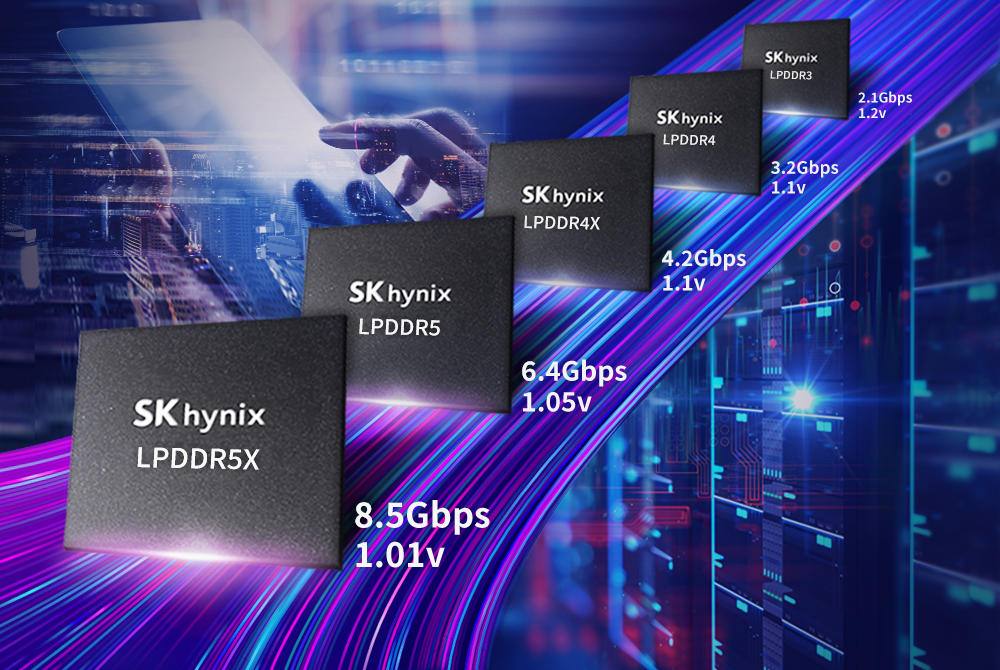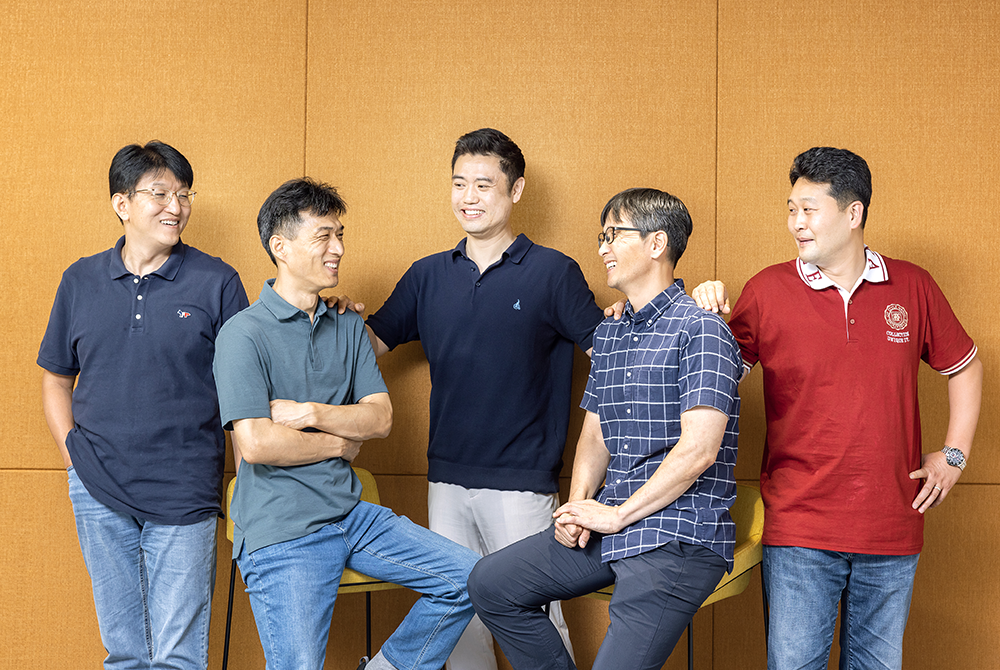
▲SK hynix’s recently released ultra-low voltage LPDDR5X
SK hynix has developed LPDDR5X (Low Power Double Data Rate 5X), the world’s first-ever mobile DRAM with an integrated HKMG (High-K Metal Gate)* process, which was just recently introduced to the market.
*HKMG: A next-generation process that uses a material with a high dielectric constant (K) in the insulating film inside DRAM transistors to prevent leakage currents and to improve capacitance. It reduces power consumption while increasing speed.
The LPDDR5X boasts the industry’s highest energy-efficiency as SK hynix succeeded in reducing power consumption by 25% compared to the previous generation and operates in the ultra-low voltage range of 1.01V to 1.12V set by the JEDEC (Joint Electron Device Engineering Council).
For the LPDDR, which is also called a mobile DRAM, having a low power consumption is its greatest asset, just as its standard name—LP (Low Power)—suggests. As power is limited in mobile devices, it’s necessary to reduce power consumption as much as possible to extend the usage time.
This is why lowering power consumption is just as important as increasing operating speed. LPDDR5X was the first among mobile DRAMs to integrate the HKMG process and see improved performance and a reduction in power consumption, essentially killing two birds with one stone.
As the power consumption of DRAM gets lowered by LPDDR5X, mobile devices can be used for a longer time with a single charge. The reduction in power consumption of such products can subsequently lead to a reduction in the power used by consumers, which is in line with the value of SK hynix’s ESG-centered business management.
Additionally, the current LPDDR5X has an operating speed of 8.5Gbps, 33% faster than the previous generation.
The industry is taking heed that SK hynix introduced the world’s first-ever LPDDR with an integrated HKMG process. The newsroom team sat down with Lee Jae Hyuk (Mobile & Auto Planning), Nam KiBong (Function Device), Cho Sung Kwon (Canopus LPD5 PE), Kim Hyun Seung (Design Quality Innovation), and Lee Wook Jae (MCP/ MO Enablement)—the people behind the successful development of LPDDR5X—to hear the story behind the development process and their unflagging commitment to its launch.

▲SK hynix’s timeline towards developing the world’s first-ever and finest LPDDR, which led to increased operating speeds and lowered power consumption
LPDDR (Low Power Double Data Rate), also known as mobile DRAM, is mainly used in wireless electronic devices including smartphones, laptops, and tablets. LPDDR is smaller and requires less power compared to other DRAM products, reducing the devices’ size and weight as well as extending usage time. The increase in demand for mobile devices, including smartphones, was a critical factor in LPDDR’s rapid development. The recent spotlight on the environment also boosted interest in LPDDR, which requires less power.

▲ LPDDR5X, which is 33% faster than LPDDR5, can download thirteen 5GB movies in 1 second
SK hynix continuously developed LPDDR without missing out on these market trends. The company mass-produced the 18GB LPDDR5, currently the industry’s largest capacity, in 2021 and followed up with the industry’s fastest LPDDR5X (4266MHZ/8.5Gbps) a year later, cementing its leadership in memory semiconductors. SK hynix then went a step further, developing an LPDDR that is 33% faster than the previous generation and allows users to download more than thirteen 5GB videos in one second. The newsroom team went behind-the-scenes to discover how the teams involved developed the industry’s best performing LPDDR5X.

▲ The team members behind the successful development of LPDDR5X smile as they reminisce about making a breakthrough together
How the world’s fastest LPDDR5X was developed
The process also requires countless people’s efforts at the planning, design, production, and sales stages. Lee Jae Hyuk, responsible for product planning during the planning stage of the LPDDR5X development, recalled the planning period as follows:

▲ Lee Jae Hyuk, Technical Leader at Mobile & Auto Planning, smiles as he explains the LPDDR5X planning process
“Planning for a new product usually begins several years in advance. When planning LPDDR5X, it was not easy to meet the 8.5Gbps specification. Various internal departments had differing opinions on how to meet this specification, but we had confidence in our capabilities and successfully completed the development of the industry’s fastest LPDDR5X on time.”
Although the interviewees and their teams can laugh about it now, they had plenty of hurdles to overcome during LPDDR5X development process. Kim Hyunseung, who was responsible for product design, recalled, “There were several challenges during the technology’s development. “How can we increase the speed further?” “How can we reduce the power required further?” It was a continuous and daily series of thoughts and meetings.”

▲ Kim Hyunseung, Technical Leader at Design Quality Innovation, explains how LPDDR5X was successfully developed
Kim Hyunseung explained how the team was able to develop LPDDR5X despite the difficulties: “The development process of LPDDR5X was somewhat unrestrictive. Typically, derivative products such as LPDDRs do not significantly modify existing circuits. However, this time, we were able to freely modify the circuit and adopt new technologies during the design process. I think this unrestrictive atmosphere and the spirit of challenge to introduce new technologies played a big part in the development’s success.”
Looking back at the LPDDR5X development process, a faster operating speed was not the teams’ only concern. Currently, LPDDR is mainly used in the smartphone market, where new products are released at regular intervals, or in other words has a short time-to-market. This meant that the successful development of LPDDR5X had to align with the market’s timetable.
Cho Sung Kwon, in charge of PE (Product Engineering), admitted that he and his team felt enormous pressure. Providing products to the market in time for the development of new smartphone releases is crucial in securing competitiveness, adding to his team’s sense of responsibility. “We are pleased to have developed the LPDDR5X within a limited time frame. Especially in terms of mass production capabilities, I feel prouder of this than any other product I have worked on so far.”

▲ Cho Sung Kwon, Project Leader at Canopus LPD5 PE (second from the right) explains the pressure he felt during the development process
During the testing process, there were moments when the team faced unexpected difficulties and concerns. “Various issues arose during the process of developing LPDDR5X. For each issue, relevant departments collaborated to identify and analyze them and developed alternatives. I credit the successful development to my colleagues’ active responses,” said Nam KiBong, who oversaw PI (Process Integration), which designed numerous process flows in semiconductor production.
A more environmentally friendly LPDDR5X in line with ESG values
SK hynix’s success in developing LPDDR5X does not end with simply developing a faster DRAM. The product operates in the ultra-low voltage range of 1.01 to 1.12V set by JEDEC*, thus reducing power consumption by 25% compared to existing products.
*JEDEC: Joint Electron Device Engineering Council, an organization that sets semiconductor standards.
LPDDR5X’s development process also incorporated ESG management efforts. Lee Jae Hyuk said, “Our work involves not only increasing the usage time of mobile devices, but also reducing power consumption more dramatically by taking the ESG aspect into account as well. Thanks to this, we expect to reduce power consumption by more than 25% compared to the previous generation.”

▲ Lee Wook Jae, Project Leader at MCP/ MO Enablement, explains LPDDR5X’s power consumption reduction
Lee Wook Jae added, “The usage time of a smartphone with LPDDR5X will be longer than that of older-generation smartphones. This is great for consumers, as they can use their phones for longer periods of time on a single charge. It reduces the frequency of charging, which ultimately uses less electricity and leads to carbon savings.”
During the interview, it was suggested that SK hynix must be more active in strengthening ESG management by implementing ESG values. Lee Jae Hyuk said, “For product development, I think that ESG values can be achieved in the actual development stage only when ESG factors are properly implemented in the planning stage.”
Cho Sung Kwon added, “We reduced the testing time further as we tested the products during the development process, and at the design stage, we designed our products to operate with the lowest possible power consumption. We are working together to incorporate ESG values as a whole in all stages of planning, design, and development.”
Building a better SK hynix with a sense of challenge
The development of LPDDR5X, which boasts improved speeds at lower power consumption, would have been impossible without the efforts of SK hynix employees. “We achieved a power consumption reduction of more than 20% for LPDDR5X, and we are proud that we are receiving a lot of positive feedback from our customers,” Lee Wook Jae, who conducts marketing, said as he reported that customers such as SoC companies are complimenting on the product.

▲ Nam KiBong, Technical Leader at Function Device, (center) talks about SK hynix’s positive future
The SK hynix employees are even more optimistic about new semiconductors that will be developed moving forward, and are confident that they can develop faster and more powerful semiconductors. “This is what I know having worked at SK hynix so far. At the beginning of the development process, I kept asking myself, “Why is this so challenging?” However, at the end of the day, once we passed through a few hurdles, things were a lot smoother, and we overcame other challenges. After the LPDDR5X’s successful development we expect to progress into developing higher performance semiconductors,” said Nam KiBong, hinting at his great expectations for the new semiconductors to be developed in the future.
Meanwhile, Kim Hyunseung specifically called for other SK hynix employees to cultivate this sense of challenge. “I have a story I want to tell my colleagues coming after me. As our company boasts a world-class semiconductor ecosystem, I hope that we as SK hynix employees will set high goals with a sense of challenge. It is vital to come up with many ideas in various areas and constantly challenge ourselves. I am confident that if we keep trying new things, we will be able to develop innovative semiconductors.”



